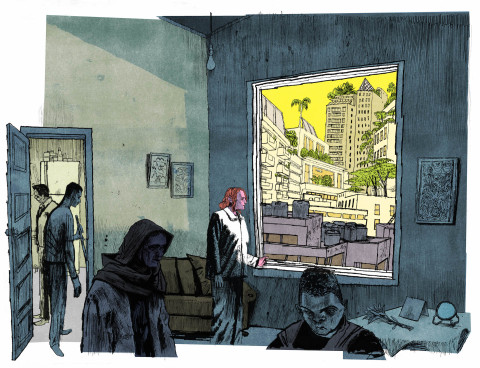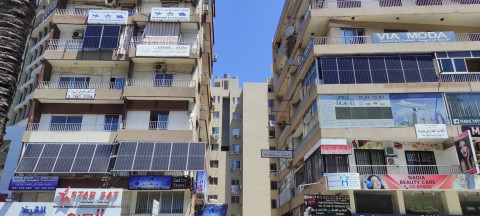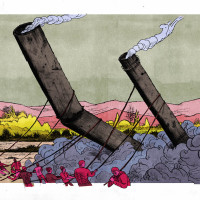Negotiating a global energy crisis on our stairwell Lessons from Lebanon
Regions
Lebanon’s unprecedented economic and energy crisis may have prompted an explosion in small-scale solar energy systems and been heralded as an example of decentralised energy revolution, but a closer look shows it also widened inequality and divided communities. The solution to energy crises is ultimately best served in mobilising communities to collectively organise against the politics that cause them.

Illustration by Matt Rota©
‘State or generator?’ A question that I have lived with for 31 years as a Lebanese citizen with (no) rights and (many) obligations. I wait impatiently for the streetlamp light, for it is the surest sign that power from the state electricity company is back on. Now a little bulb has stolen its glory, a sign that the power from the generator is on. I’m attached to this little bulb the way I am attached to the little hope that tomorrow will bring us more state electricity power than the day before.

Finding our way in the dark
The financial crisis led to an economic collapse in Lebanon, where inflation rose to 145% and an increase in the cost of imported fossil fuels meant the price of electricity, gas and diesel increased by almost 600%. This led to an electricity crisis with still further reduction in state supply, as well as a six-fold increase in the cost of diesel generators.
The response to the intense electricity shortage incurred high social, economic and environmental costs, exacerbating income inequality and energy poverty, with 90% of households compromising on paying for basic services.
Among the poorest, 20% lacked access to a generator, with low-income households paying a substantially higher percentage of their income for private electricity supplies,10 while environmental experts estimated a significant increase in emissions, magnifying health risks.11 In addition, just like elsewhere around the world, these impacts are gendered, with the hardships of supply shortages falling disproportionately on women.12
The macroeconomic cost was a deepening of Lebanon’s dependence on diesel imports that benefit primarily an oil importers’ cartel to fuel private generators,13 further entrenching politicians’ networks of power and influence.
At the other end of the crisis are people’s strategies for meeting their daily energy needs. Individual or collective solutions in buildings and households are now commonplace. We refer to these as ‘micro fixes’; privately led and small scale, constituting a mosaic of energy sources (building generators, neighbourhood generators that sell electricity, solar panels, inverters with lithium or acid batteries). This is also the bulk of electricity generated and effectively the unwritten national strategy for energy provision in the crisis-ridden country.
With more people resorting to micro fixes, the country saw an explosion in small-scale solar energy systems, which some celebrated as a ‘solar power revolution’14 that, they argued, could even enable Lebanon to meet its 2018 commitment of 30% renewable energy mix by 2030.15 However, the country’s solar rush has been mainly individual and private-led, underscoring class differentials in access to quality solar energy given the high cost of purchasing the panels, batteries and inverter equipment required. Furthermore, there is a ‘looming toxic waste crisis’16 arising from all the expended batteries and panels, with no plan for its management on the horizon.
The lack of an effective subsidy loan programme has driven a profit-based model of the solar energy market, a negative aspect of the energy transition noted earlier.17 This, along with the complexity of energy provision in Lebanon, brings to mind the question of energy justice. Lacking a ‘universal access to affordable, reliable and modern energy services’,18 with severely negative environmental and intergenerational impacts on residents’ wellbeing,19 it is evident that energy provision in Lebanon and the potential transition to renewables are not just.
Thinkers on energy justice define it as a ‘global energy system that fairly disseminates both the benefits and costs of energy services, and one that has representative and impartial energy decision-making’.20 Principally, their vision asserts the right to affordable and sustainable energy, where its provision is transparent and accountable.
A year before the height of the crisis, a Lebanese citizens’ assembly in 2020 elicited an ‘imaginary of interdependence that seeks to create communal integrated networks as a collective small-scale solution at a time when nation-wide solutions are not perceived as possible’.21
This desire for a locally led solution independent of the central state stems from a lack of trust in the ability of the state or private partners under its wing to resolve the decades-old energy problem, as well as a lack of confidence in renewable options and a dystopic outlook that rightfully predicted further deterioration in energy provision. We highlight people’s mistrust of the state and its institutions as testament not only to how entrenched and historic the electricity problems in Lebanon are, but also to how people recognise the corruption in the sector but are disempowered in the face of it.

Living in the electricity crisis
The electricity crisis meant households almost exclusively relied on electricity provided by diesel generators. To clarify, a building generator is owned by a building and serves the residents who have paid for its operation and maintenance, whereas a private neighbourhood diesel generator service is another option to which individual apartments subscribed (for a monthly fee) for only a small number of amps.
Sami writes how ‘electricity from EDL was always the dream’ as that is when he can consume more than the rationed consumption of only 5 or 10 amperes from the generator. The crisis shattered that dream and created an affinity with the diesel generator to which Sami is subscribed, whose owner he feels ‘is with us and nothing is against us except our state and its luminescent electricity company EDL’. Sami’s feelings reflect an ambivalent relationship to the state and its institutions, the failures of which markedly shape the political imagination in the country. That ambivalence is extended towards the owners of diesel generators too, who have been notable for their greed and lack of accountability.
The electricity crisis entrenched itself as an enduring reality, dictating the daily rhythms of household life. ‘We began to plan our lives around these cuts: what time we woke up, what time we got back home, our shower and meal schedule’, wrote Yasmin.
Everyday chores were organised around the generator schedule and daily life became a constant struggle like ‘a never-ending swirl’ as Sami notes: the laundry piles; sleepless nights in the summer with no air-conditioning; amps not enough for high-wattage appliances like water heaters. Now their daily life is also being rationed, ‘lights go off at 11pm, at 12am or even 1am…time to go to bed, and everyone goes to sleep at the same time’.
Coping and adaptation mechanisms alternated between individual solutions and exploring collective possibilities, often involving experimentation with new technologies. Given the market-driven system in Lebanon, new solutions – the micro-fixes – were available to those with financial means.
In contrast, residents who relied solely on the private neighbourhood generator often felt trapped in a dependency relationship, since shifting from one provider to another is costly – if it is even possible to do so.
Some exhibited hostility towards these providers as they railed over the spiralling cost of living that the financial crisis brought, but at the same time they needed the power amidst almost blackouts. As Sami wrote, the private providers manipulated people’s lives without restraint or oversight. In doing so, they gained even more power as for many people the cost of other options made them the only choice.

Ebla Research Collective
The crisis is felt more severely by those with health or care needs, such as the elderly and people with disabilities who need to take an elevator to reach their home, but who now have to time their outings according to the generator’s schedule. The option of walking up flights of stairs is also difficult for people of all ages, as Yasmin notes:
‘I had never realised how high twelve flights of stairs were until I had to climb up them almost every night … going up the stairs, again and again, I started to feel like I was outside of time, like the staircase stretched infinitely and held me in a loop that would never end’.
That feeling of the unending – the swirl, the infinite loop – speaks of exacerbation. A fatigue pervades everything, placing at its centre the bodies of those living through the crisis. We highlight these feelings to pinpoint the intangible impacts the crisis has on people, given how entangled everyday life is with electricity. Bodily experiences, ambivalence regarding state and non-state actors, and a seemingly oppressive routine existence can have social and political implications with significant consequences.
The response to the crisis has not only exacerbated existing social and economic inequalities but has – in its very design – further entrenched these power imbalances. For example, the process of rationing power from building-owed diesel generators (to manage costs and mechanical wear and tear) revealed conflicting needs and priorities, and experiences differentiated by gender, family size and composition, as well as financial and social standing.
While homemakers preferred a supply during the day, those working outside the home wanted to follow their job schedule, and well-off households wanted more supply no matter the cost. Negotiations and adaptations became necessary, often leading to the needs of the weakest being de-prioritised or even ignored. In decision-making, there was an absence of women’s voices, sometimes deliberate and sometimes not, given issues such as childcare and other demands on their time.
This dynamic shows that even when decisions are local, power differentials are exploited. The intersection of inequality with community or collective approaches to problem solving in this case have been detrimental to weaker groups, highlighting how justice continues to be a concern even in local-level responses.
In contrast, buildings with financial means and well-networked residents were able to secure diesel more easily, shielding themselves from the worst of the crises. The high-income building described by Yasmin became ‘a fortress that at once protects and distinguishes its residents from what is outside’.
However, the advantages enjoyed by the higher-income households are not without costs borne by the less fortunate. In this example, the noisy 24-hour generator had ruinous mental health and wellbeing impacts on the poorer residents of nearby buildings. Personal connections to influential political parties and elites were exploited to help secure cheaper diesel, while in another building, the committee leader’s connections to a political party further entrenched his dominance over the neighbours.
We see clearly how the impacts of the crisis have fallen most severely on lower-income buildings. Higher-income buildings, despite the crisis, continued to invest in building maintenance and the general upkeep of common areas, whereas those with households of average or lower income began to suffer the decline in visible ways. Privilege and prestige in Beirut’s buildings are no longer the showy entrance, electric gate or gleaming façade, but rather the near-constant hum of a diesel generator providing ample hours of convenience and cool environments to their residents.

Buildings in the midst of the electricity crisis
In a building, three of the common areas that require collaboration to implement energy solutions are: (1) the shared building amenities that need electricity (elevator, water pump, stairwell lights etc.); (2) a diesel generator owned by the building; and (3) the use of common areas to install energy solutions, such as allocating a space for the generator or using the rooftop for installing solar panels.
There was a time element to this crisis, as noted by Fadia, who observed how initially neighbours were open to enduring reduced hours, sacrificing comfort and convenience so that shared bills were affordable for everyone. However, as the crisis unfolded over the months and the months became years, that solidarity gave way to impatient co-existence.
Feelings changed and assertions were followed by ‘those who haven’t paid their share of the generator bill this month shouldn’t protest’. Lengthy and often antagonistic meetings and discussions took place, pushing people to adopt individual solutions, such as lithium-battery systems for their homes. This alleviated problems for those who could afford such solutions, but reduced the impetus to find consensus-based solutions. Individual solutions became a panacea for people to take care of their own needs and reduce ‘the headache’.
The management of shared amenities raises concerns too. The elevator requires some form of cooperation to ensure it is regularly maintained and its electricity bill is paid, whether covered by the building generator or requiring a separate subscription from a neighbourhood generator service. When residents could not afford to pay or to invest in lithium batteries to run it at all times, some committees opted to limit use only to those who could afford it.
Using a remote-control system, the elevator could be called only by those who have paid. With grid electricity now available only for a few hours a day, the elevator was rendered for the private use of the wealthier residents and no longer a basic amenity. In that sense, this mundane building service became a site of the unfolding crisis, producing exclusionary practices and alienation among neighbours.

Ebla Research Collective
The use of common areas, like the roof of the building, proved them to be not so common after all. Much like the city’s commons more broadly, such spaces in buildings have often been encroached upon, either by emerging needs for new amenities and services (e.g. water tanks on the roof or shared garden area) or by a neighbour who manages to take over and limit others’ access, such as rooftops becoming extended terraces for a top-floor resident.
In view of this, and the reported solar boom in Beirut and its suburbs, a question arises of whether households truly have access to building’s rooftop. In the buildings we researched, only three had solar panels installed, but these belonged to the few households who installed panels without consultation or agreement with the neighbours, in a fait accompli. Although in some suburbs of the city solar-powered electricity services have started to crop up,22 we did not observe any collective effort to invest in solar energy in our sample. This was discussed in one building with the committee assuming it was illegal, while others decided that the roof space may not be large enough to accommodate the necessary panels.
Such examples show that while in some buildings there were committees that met, agreed, planned and invested in solutions to ease the crisis impacts in fair and accessible ways, these options were not always strategic, effective or inclusive. Although higher-income buildings could resolve problems by collectively purchasing bigger generators, this does not mean that the economic angle is the only factor at play.
The intensity of the electricity crisis coupled with mounting financial burdens on families makes cooperation far harder as fewer people can spare the time and financial resources that such initiatives require. Another cause for failure is the length of the crisis (now entering its fourth year) as evidenced in people losing their patience and opting for individual solutions. As such, cooperation ebbed and flowed over time, sometimes emerging in shared spaces and at other times disappearing under the stresses and strains of living in a crisis.
Nevertheless, building committees are still important for the country’s towns and cities. Research has shown how they are instrumental in protecting the built environment from decay, where neglected buildings are sometimes the ‘deliberate debris’ driven by neoliberal policies that encourage demolition, rebuilding and speculation in property markets.23
Given that before the crisis building committees were effective in (mostly) maintaining and managing generator services or finding solutions to relatively small problems such as irregular water supply, one question is whether this crisis – in its complexity and multiple impacts – is too big for a building committee to manage on its own.
This underscores our call for a critical view of efforts dedicated to localised solutions, especially those that do not sufficiently consider the structural forces that can severely delimit peoples’ responses. The concern here is for how effective localised solutions can be when state failure is so stark and how likely it is that these solutions will be successful in the long-term.

A crisis unfolding
The dynamics of building committees can capture how people adapt everyday routines to the constrained electricity supply, which they negotiate with their neighbours to ensure that the provision matches their needs. They can be sites for seeking out collective micro-solutions and we also found life-enhancing and resistance strategies that challenge an unjust energy reality, as residents attempt to achieve solidarity, collaboration, and collective action – if only temporarily.
We recounted on-the-ground experiences of the energy crisis arriving at people’s doorsteps, requiring them to find collective technical solutions with the distributional and procedural aspects of justice implicit in their decision-making, but also while they succumb to the global, state and systemic energy injustices.
We showed that even with good intentions, the added responsibilities in relation to providing electricity proved too complex for individual building committees and increased the burden imposed on them by the failing state. From an energy justice perspective, this is far from the expectations of democratisation in access to energy and community empowerment that we might imagine from policy and activist discourse.
Consider the example of Um-Rami, a 78-year-old grandmother who has been in charge of the committee and bookkeeping in her building for two decades. She writes everything in two little notebooks in which the building expenses and income from residents’ contributions over the last 10 years are recorded chronologically. There is also a small metal box containing any remaining cash, bills and receipts.
At the end of each year, she calculates the totals and carries them over to the next page. Um-Rami complains of still being responsible for this task, of how she is tired and making mistakes in the calculations. Maya recalls trying to support her over the years by keeping an Excel file with two sheets for each year, one for expenses and the other for income, in order to produce a yearly report for the residents. She too is tired, struggling to find the time between work, housework and raising her children.
Shifting the weight of a solution for the energy shortage – a decades-long national-level problem in addition to a global climate crisis – onto the shoulders of city dwellers like Um-Rami is not a democratisation process nor is it empowering. Indeed, even among younger or more technically skilled committee members, managing such a system is taxing. These committees are struggling to maintain the services necessary for their residents’ everyday life while grappling with a dynamic political crisis, currency devaluation, and fuel shortages.
Given the scale of the energy crisis and the corruption in Lebanon, the empowering response is not the stopgap measures that Beirut’s dwellers have been forced to adopt, nor is it the deployment of small-scale expensive and environmentally questionable technical solutions, nor indeed thinking that the answer lies in community energy. The energy crisis is political – and demands a political response.
To clarify, energy justice scholars and activists call for decentralised and community-directed energy systems24 and returning ‘the mic to marginalized communities whose voices have been systematically silenced for far too long’.25 But without parallel political action to dismantle rent-seeking political systems in the global South and the neo-colonial regimes that sustain them and that reap the benefits of unjust and extractivist energy systems, calls for decentralisation and community energy risk reinforcing the injustice.
Communities, as we have seen in Lebanon and elsewhere in the global South,26 are then expected to bear the burden of meeting their energy needs on the debris of failing energy systems, but without the power and resources to do so.27
Grassroots efforts are thus arguably better devoted not to deploying technology-focused solutions to the energy crisis, but to helping collectively organise against the politics that caused it. Although the corrupt state elites have succeeded in quelling opposition through a tightly knit clientelist and sectarian-based populist politics, mobilisation has helped move the discussion on services and infrastructure.
For instance, previous mobilisations, such as the #YouStink campaign,28 despite its limited success, rightly pointed to the political corruption that led to the waste crisis, rather than focusing on technical solutions for solid waste management.
Furthermore, for individual households, the building committee as a unit is still of great relevance, certainly as a starting point for defining and voicing community-level needs and priorities. These committees operate within an urban ecosystem; one that encompasses neighbouring buildings in similar circumstances, informal service providers including generator owners and local electricians and, where they are active, local municipal authorities.
We saw some examples of this cooperation, such as one building committee that attempted to procure a generator together with a neighbouring one, or sometimes negotiated subscription rates jointly with neighbourhood private providers, while another building committee takes note of a fire at a neighbouring generator to improve safety measures in their own building.
The role of the generator providers, often demonised as a mafia given their monopoly of neighbourhood services and their price fixing, could be managed in a different way.29 We question this simplistic labelling, given people’s mixed feelings that emerged from our study. We argue that there is room to engage them in ways that go beyond transactional service provision.
They are supplying services at a relatively large scale that the state is failing to provide and that people are struggling to manage at the level of buildings. The ideal is by no means a continued reliance on neighbourhood-level generator services, given the lack of accountability and the environmental health consequences. Despite being private entities, they are – much like the neighbourhood grocery store – also part of their communities and enmeshed in its network of relations and patronage systems.
Support should be provided so that resident collectives can push for improvements in conditions of service, not least the reduction of noise and emissions. A third necessary partner who can support residents are the municipal local authorities. The one building where the municipality took on an active role in regulating the private generator providers, residents benefited from having a less stressful management of their everyday energy needs.
Building committees continue to be crucial spaces for collective organising in Beirut’s complicated urban context. However, in efforts to achieve energy justice, the social capital and skills of organisers at the building level, like Um-Rami, might be better invested in strengthening bridges between neighbouring residents, mobilising for effective political change and pressuring service providers and local authorities for more just energy solutions.
Years of corruption and the unchecked power of the ruling elite in the country make any effort to support the transition to greener energy or to address energy poverty particularly challenging. Lebanon’s energy crisis is not a technical problem that local community-led energy projects could simply alleviate.
These insights make us ever more convinced this is a political crisis – from years of brazen power grabs by corrupt politicians who gained influence over its energy infrastructure – and a political solution is imperative.






